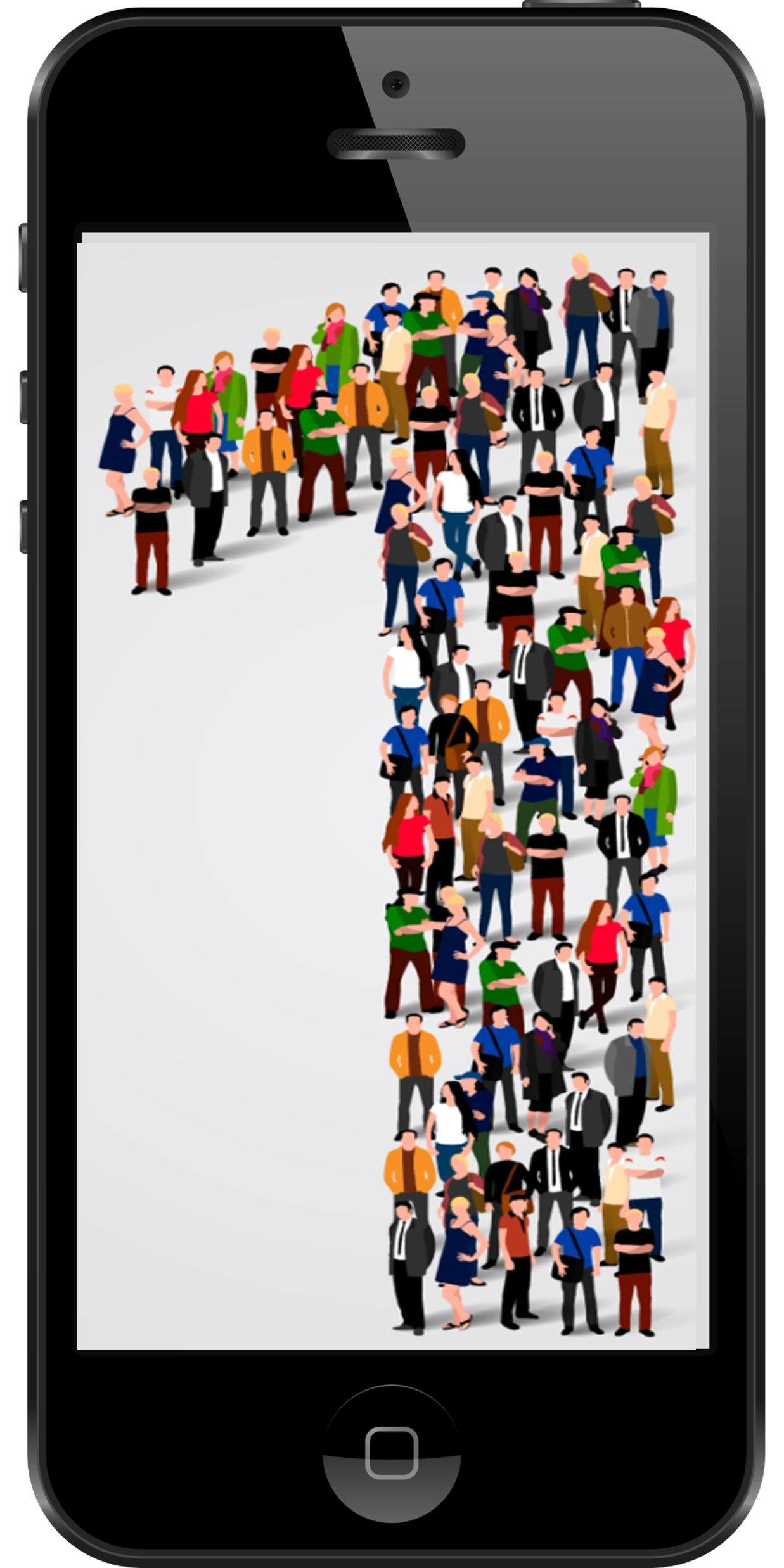
Yesterday’s post about the need for radio broadcasting’s CEO’s leading their companies through the technology maze was stimulated by a recent Gartner survey of 281 board directors and corporate board members. It was conducted online among respondents in North America, Latin America, Europe, and Asia/Pacific in June/July of this year.
Gartner analyst, Partha Iyengar, explained that many traditional industries – banking, retail, telecom, and healthcare, among them – will be dependent on their CEOs making the tough technology decisions.
Mobile features and usage patterns are key areas in this digital transformation, and banking is a business where they have come into sharper focus. As CIO Dive‘s Lindsey Wilkinson points out, “Mobile in the banking sector has become more and more the norm, pushing the industry to reimagine the value technology could bring. It’s amazing how those smartphones come in handy when working with our finances.”
Radio could use more of that way of thinking with its mobile strategies. Watching just about any TV ad for a bank these days reveals how these companies are envisioning the advantages of mobile usage across customers of all ages and generations:
So, how does radio view the mobile opportunity? I can attest to the ways in which broadcasters are more enlightened about mobile today. We launched jacapps about 100 days after Apple opened its now-famous App Store way back in 2008. Fourteen years later, the majority of radio stations now have a mobile app of one kind or another. And that’s a good thing.
But what capabilities do these apps have, and how have radio digital teams taken advantage of mobile’s many possibilities?
A look at those who have downloaded their station’s mobile app in our new Public Radio Techsurvey 2022 shows that streaming the station is far and away the #1 use case. There’s nothing wrong with that, of course. But mobile can play an even greater role in engaging listeners.
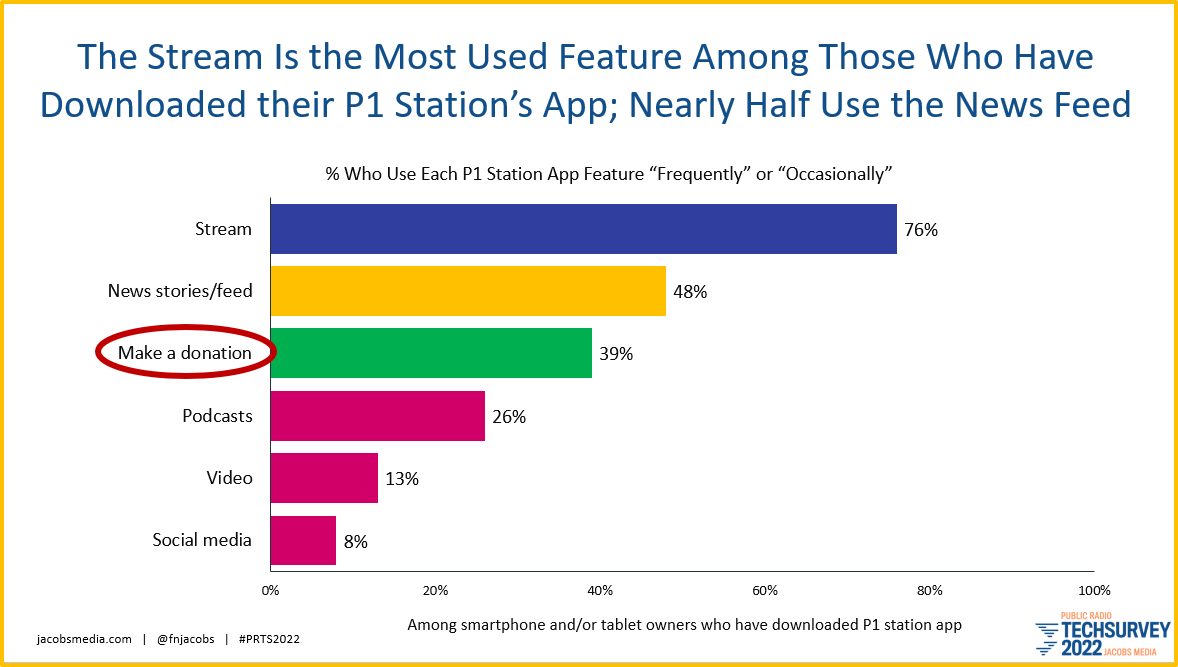
Nearly half use the news feed feature (especially popular on NPR News stations). But note how fewer than four in ten (39%) say they frequently or occasionally use the app to make a donation. For radio stations highly dependent on listener contributions, you would expect more usage for mobile giving.
In spite of its obvious value and the ease of use of mobile donations, many public radio stations don’t really focus on this feature in their app, instead relying on shopworn “pledge drives” that generally fail to resonate with younger listeners. But if the app allowed for easy contributions to the station, how many more Millennials would simply click a donation in their carts and head for the check-out? Every public radio executive will tell you the importance of attracting young people to the medium. Why not start on the device that defines their lives, the one they live on?
And that’s just contributions. Clearly, a mobile app for (public) radio could provide other smart utilities and conveniences that would satisfy and even delight station fans.
It starts with a concerted “Mobile First” mindset, with an emphasis on listening to existing customers. That’s clearly how other businesses perceive the vast mobile opportunity. If your station has its own app, there’s virtually no limit on what you can do in the space. And this is another reason not to have an aggregated app with hundreds of other stations, a limiting factor in optimizing mobile’s amazing possibilities.
opportunity. If your station has its own app, there’s virtually no limit on what you can do in the space. And this is another reason not to have an aggregated app with hundreds of other stations, a limiting factor in optimizing mobile’s amazing possibilities.
You’ve no doubt read the wild predictions:
- Apps will become a thing of the past.
- Smartphones will soon be replaced by smart glasses.
- The Lions will win the Super Bowl.
None of these things will happen…at least anytime soon. And with the exception of the last one, consumers have become even closer to their smartphones and the apps that make them special and unique.
Why is it so important stations lean into their mobile strategies but also put a priority on serving their audiences? Because the data makes it an imperative.
Last week, I talked about Ford eliminating AM radio from its F-150 Lightning EVs. That means AM brands will only be app-accessible in these vehicles. Can we expect more automakers to save some money on their next generation of electric cars and trucks? I think you know the answer. This is where smartphones become the equivalent of transistor radios or Walkmans. And apps are the pushbutton presets.
A look at how smartphone ownership has become nearly ubiquitous while a working radio at home is now on the “endangered gadget” list is proof positive. Here’s another slide from PRTS 2022 showing the trajectories of each:
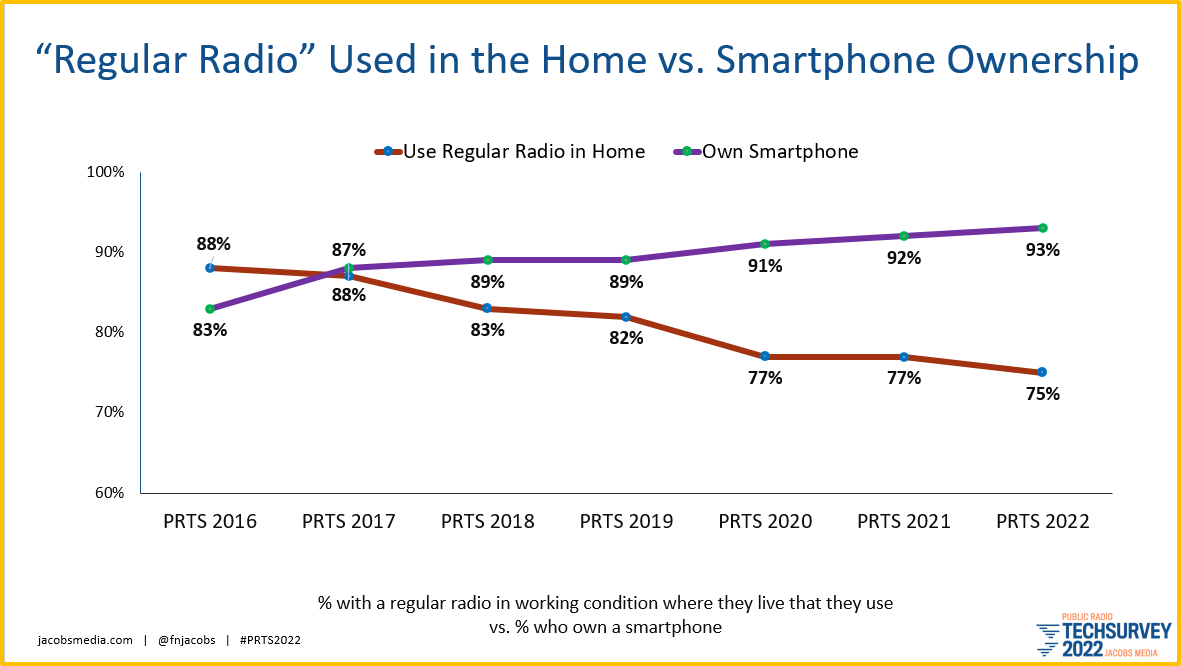 Wonder what it looks like in three years? Five years? I think we know.
Wonder what it looks like in three years? Five years? I think we know.
And yet when you listen to your average radio station – public, commercial, whatever – how often are they promoting their broadcast frequency versus their mobile app?
How many brainstorms and strategy sessions revolve around new app features and capabilities instead of thinking about over-the-air programs?
How often do stations encourage listeners to download their app, providing great reasons for doing so? (Think about the Chase Bank app TV ad.)
And how much research “real estate” do stations devote to their mobile app, learning how it can be more useful for listeners, and how broadcasters can expand their mobile footprint?
more useful for listeners, and how broadcasters can expand their mobile footprint?
The Gartner study suggests the mission to “think mobile/audience first” has to come from the corner office. It’s a major step that requires decision-making from the company’s highest-ranking corporate officer.
Who knows? Shifting the company’s focus in the mobile direction might just impress some of those Wall Street bankers. The numbers back it up. A new study of audio consumption reported in Inside Radio last week shows that both radio and mobile consumption are up in the first six months of this year among Internet users.
Conducted by Inside Intelligence/eMarketer, the Global Media Intelligence Report provides a nice hierarchy of time spent with various media outlets among web users here in the U.S.
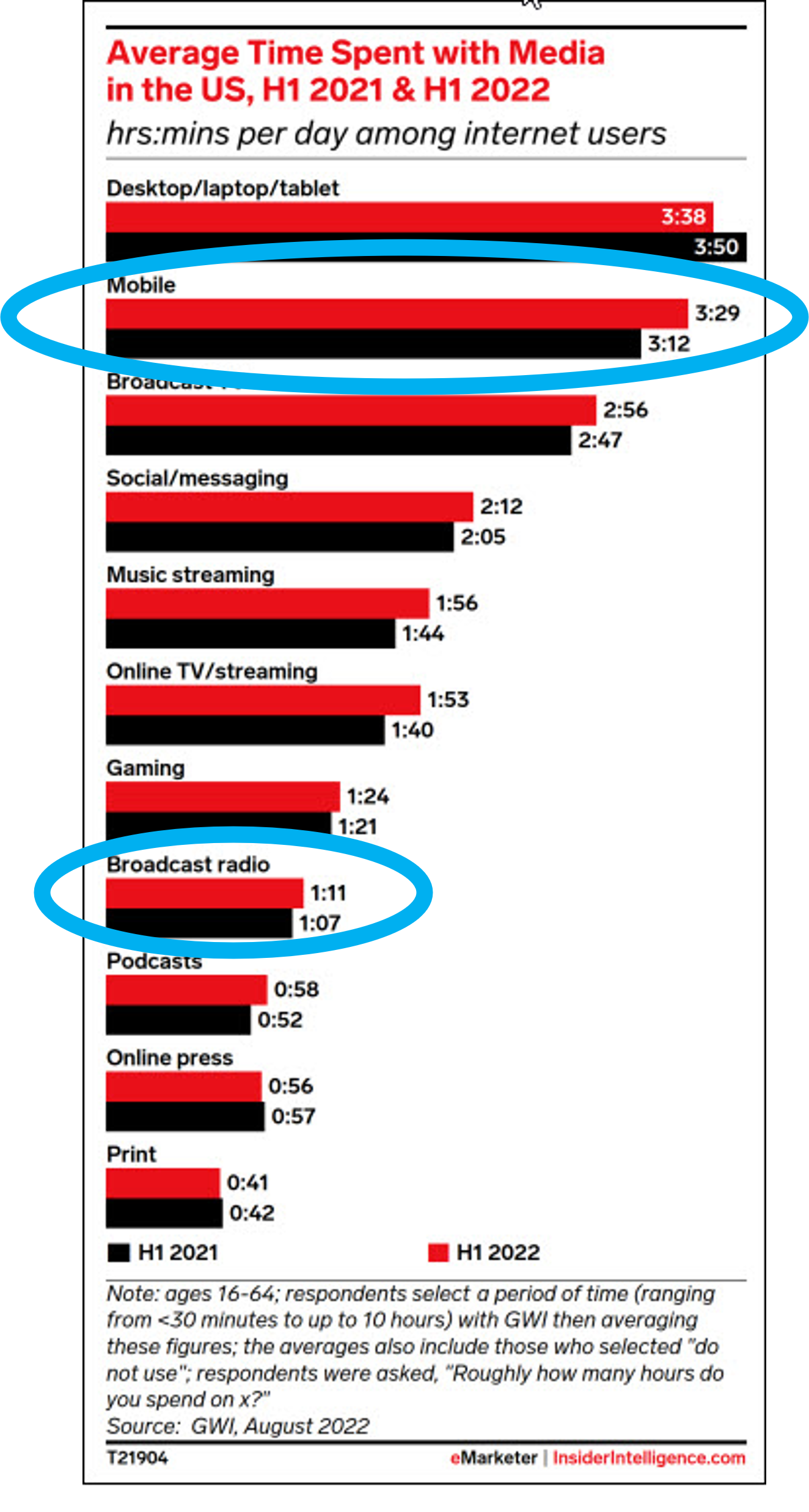 That mobile is “up” isn’t a surprise. Not only are cell phones ubiquitous, but we continue to use them more and more. Now we average 3½ hours a day on these devices, second only to how much time we spend on our computers (and for some reason, tablets aren’t listed under “mobile”).
That mobile is “up” isn’t a surprise. Not only are cell phones ubiquitous, but we continue to use them more and more. Now we average 3½ hours a day on these devices, second only to how much time we spend on our computers (and for some reason, tablets aren’t listed under “mobile”).
And then there’s radio, the little medium that could. At an undeniably difficult time for traditional media, with many still not commuting to and from their jobs, broadcast radio is “up” also – a respectable four minutes a day.
Now, I fully realize other media and activities were also on the rise in the first half of 2022 – including podcasts, music streaming, streaming video on-demand, and even social messaging
But closer to home, radio has a pulse, and the mobile surge since the beginning of the “App Economy” in 2008 is still going strong. These are more green lights on  the tech highway that should signal opportunity for radio operators.
the tech highway that should signal opportunity for radio operators.
But it starts with a “Mobile First” mindset, and a commitment to serving audiences and communities. For radio broadcasters, this isn’t just aa good idea, but it might be a key component in the industry’s survival strategy. Noting that “smartphones are ubiquitous,” the report goes on to make the point that “mobile media consumption continues to displace viewership and listenership in traditional channels.”
In other words, get on the mobile bus in a serious way or risk being passed by. And an aggressive mobile plan for radio brands also translates to better presence in cars, thanks in no small part to the growth spurt we continue to see for Apple CarPlay, in particular.
The key to the “connected car” is content drivers (and passengers) have on their smartphones. You station needs to have a strong presence on their mobile phones.
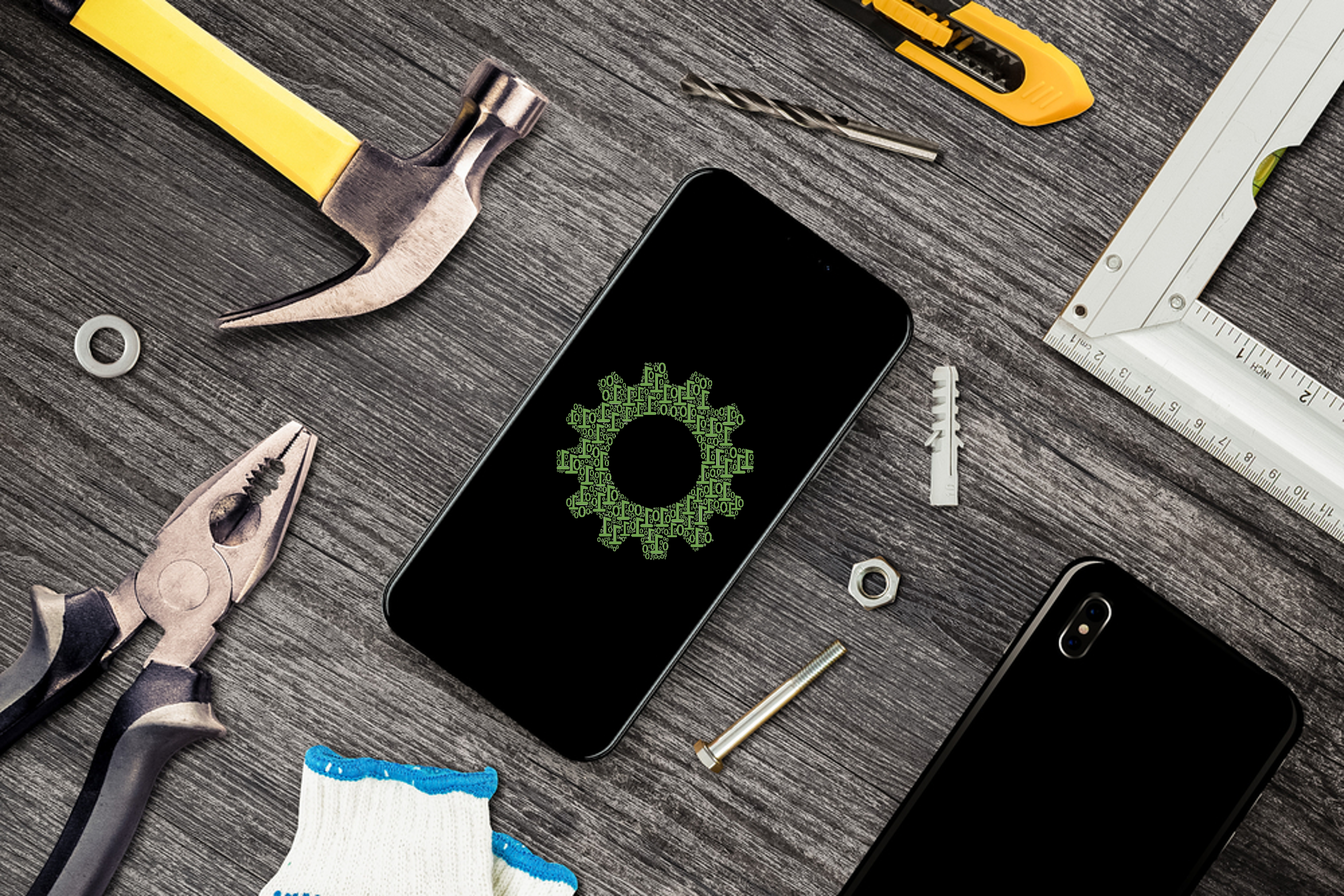 Up to this point for radio, mobile has been a box to be checked, just another tool in the digital tool kit.
Up to this point for radio, mobile has been a box to be checked, just another tool in the digital tool kit.
What could it become to broadcasters who look at it as just another distribution outlet? How could it be used to forge radio’s non-existent Gen Z strategy? How does mobile figure into radio’s need to reconnect with its local communities? What kind of content can radio broadcasters create (and monetize) for smartphones only?
Imagine a “Mobile First” next phase for radio. And let’s answer these questions.
P.S. To see the latest and greatest in smartphone technology, as well as a front seat to see cutting edge innovation and digital media, join us for our Jacobs Media CES 2023 Tour. Details here.
- I Read The (Local) News Today, Oh Boy! - April 15, 2025
- Radio, Now What? - April 14, 2025
- The Hazards Of Duke - April 11, 2025




Great column, Fred.
I’m curious what role mobile plays for stations in rural areas where internet access isn’t always guaranteed?
Of course, getting a terrestrial radio signal in a rural or mountainous area isn’t a sure thing either, but stations make investments to fill in the gaps, add signals, and the entry point is low. Whereas a local station can’t really get Verizon to upgrade broadband access in their area.
As for connected cars doing away with AM and perhaps even FM someday, won’t this just further the digital divide as it related to internet access in urban versus rural areas?
Excellent points. As to using the phone in cars to pick up radio band(s) no longer served by the vehicle’s “infotainment” center, has the radio chip in that phone been activated by the carrier? Might the phone’s owner use that chip instead of apps and expensive cellular data to receive stations? OTA will always be more robust than cell towers, let alone the internet.
The FM chip “solution” never took flight, thanks in large part to the handset makers AND Apple not believing it was necessary or cost effective for them.
Michael, it’s a tougher putt in remote areas where WiFi is spotty or nonexistent. In time, those gaps will be filled, but between mediocre radio service and unreliable Internet, the listening options aren’t as good as they should be. Radio broadcasters can prevent the “digital divide” by embracing streaming distribution outlets that allow them to reach more people on more devices.
Wondering.. does focus on the app come at the expense of terrestrial FM listening? Directing listeners to the app is different that directing listeners to *listen* on the app – in effect telling them to turn off their FM radios. A lot of stations are doing app-only contesting to coax listeners into using the app. Seems to me simply converting terrestrial listeners to digital is a zero sum game – at best it reduces listener attrition. Ideally the station would want to grow their app user base from outside their existing listeners. Could traditional marketing used to promote radio stations (billboards / TV spots /direct mail) effectively direct new users to the app instead of the station? Seems we’d need entirely new digital audience building strategies, then marry the expectations of new users with those of traditional radio converts.
Jeff, it’s not about US (the broadcasters). It’s about the listeners, and meeting them with our content where and when they seek it. If they don’t have a radio at home (25% of public radio fans, for example, do not), how can they listen. On our mobile app. Streaming on a laptop. By asking Alexa to listen. All of this involves providing these “distribution outlets” and then marketing them to listeners so they’re aware they can listen. And yes, any kind of marketing would make sense at this point. Thanks for reaching out and commenting.
I was thinking the same thing that you were, Jeff.
I’ve never understood why more cell phones don’t have an FM chip in them, if for no other reason than some kind of emergency.
Good points and thank you for sharing.
As I understand it, virtually all smartphones have the capability for FM reception, but that has to be activated.
My Motorola phone activates that function as part of the Android OS, but I don’t know if that is manufacturer-specific, or a decision made by the wireless provider (in my case, Consumer Cellular, using T-Mobile’s network) or even if iPhones also have that capability.
I do know that on my phone you have to use wired earbuds, because the cable acts as the FM antenna. Is that also going to be a turnoff to listeners who are increasingly migrating to wireless earbuds? (And what if I wanted to listen using the phone speaker?)
Read Jeff Smulyan’s upcoming book. I’m sure he’ll tell us exactly what the problem is with FM chips. If the handset companies don’t activate or build them in, us consumers aren’t going to have them.
And what’s their motivation to include FM chips? They owe nothing to radio broadcasters, and they’d rather we stream content on their handsets rather than tune in an FM station.
Jeff’s “Next Radio” technology was predicated on the FM chip. Apple’s refusal to play ball was a pretty good reason why “Next Radio” was unable to progress.